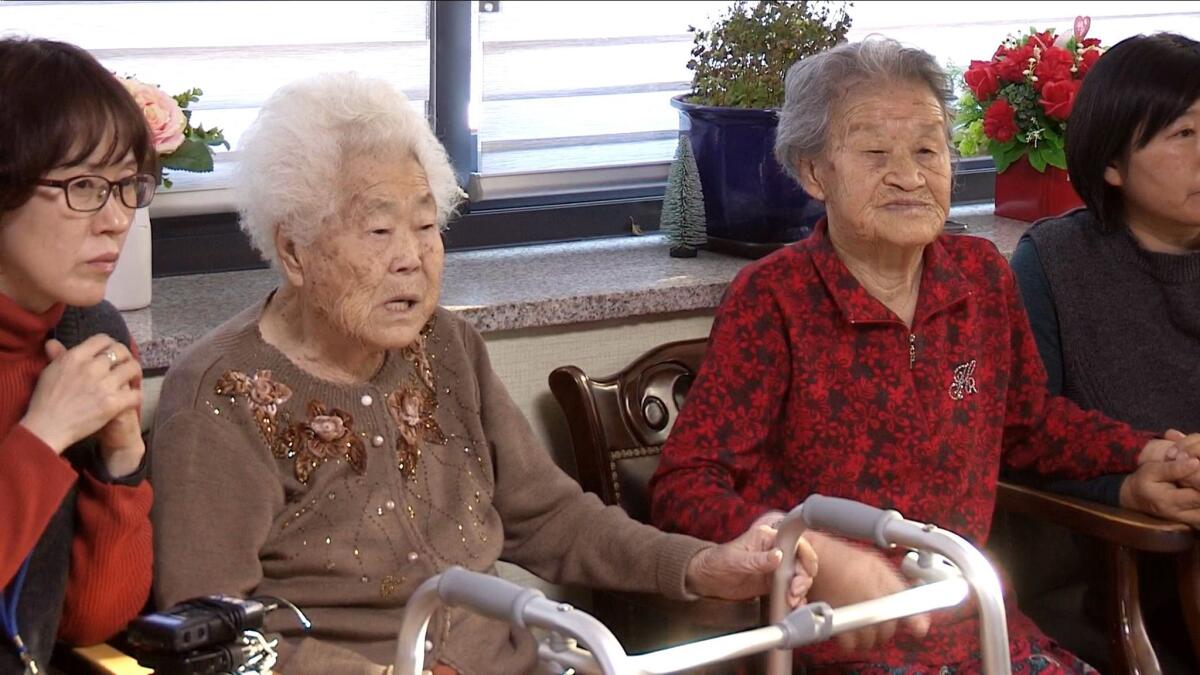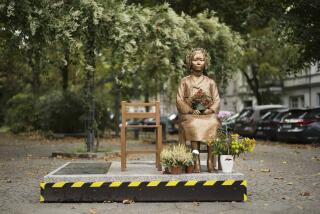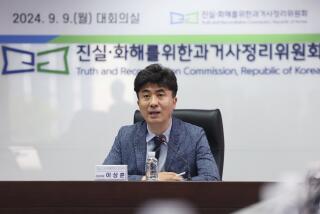Dispute flares anew between Japan and South Korea over World War II sex slaves

- Share via
The pain behind the euphemism ianfu, or “comfort women,” has reverberated for more than 70 years. Forced servitude in Japanese wartime brothels ensnared as many as 200,000 women from across a wide swath of Asia, and although the surviving cohort is dwindling down to dozens, the historic wound refuses to heal.
An agreement two years ago was intended to formally settle the dispute between the governments of Japan and South Korea, where the bulk of the “comfort women” came from. But South Korea this week deemed the accord seriously flawed, while Japan insists that any attempt to revise the pact would be unacceptable.
Systematic sexual enslavement and abuse of women in times of conflict has many modern-day echoes: African girls seized by Boko Haram, Yazidis held captive by Islamic State, the widespread rape of fleeing Rohingya women by the Myanmar military. But the “comfort women” issue takes on different dimensions because of the still-contested question of the Japanese government’s role, and the issue’s potential to inflame ties between two important U.S. allies at a time of high tensions over North Korea.
From the archives: ‘To tell you the truth, some of these old ladies are grouchy’ »
Here is some background on the decades-long legal, political and moral struggle surrounding the women:
How was the “comfort women” system created?
Tracing a trajectory of Japanese military aggression against its Asian neighbors, a vast network of brothels to serve troops and contractors operated from 1932 to 1945, when World War II ended. Most of the women were procured from Korea, which was under Japanese colonial rule from 1910 to 1945, but others came from China, the Philippines, Indonesia and elsewhere, including small numbers of Japanese and European women. Their precise numbers are not fully agreed upon; advocates and many historians place the figure at 200,000, but some estimates are lower.
What did the December 2015 accord say?
In what was hailed at the time as a landmark pact, Japan agreed to set up a fund of 1 billion yen, nearly $9 million, to benefit the elderly South Korean survivors. Japanese Prime Minister Shinzo Abe expressed remorse and acknowledged the “immeasurable pain” suffered by the women. South Korea, for its part, agreed to refrain from public criticism of Japan over the issue, and to take steps toward removing statues commemorating the victims, most notably one that was placed in front of the Japanese Embassy in the heart of Seoul. South Korea’s foreign minister at the time, Yun Byung-se, said full implementation of the accord’s terms would represent a final resolution of the “comfort women” dispute.
How has the issue affected domestic politics in South Korea and Japan?
The 2015 agreement was problematic from the start for leaders on both sides. South Korea’s then-president, Park Geun-hye, was forced out by a corruption scandal, and her successor, Moon Jae-in, — buoyed by public opinion polls suggesting the public thought Japan had not gone far enough in accepting responsibility — made changing the “comfort women” agreement part of his successful election campaign.
In Japan, Abe has long sought to appease conservative nationalists who bitterly oppose any government admission of wrongdoing in connection with the wartime brothels. Even while apologizing for the suffering of the “comfort women,” the Japanese leader has said the issue should not “drag on into the next generation,” suggesting little appetite for future expressions of remorse.

What is the U.S. interest in the dispute?
Successive American administrations have worked to encourage better ties between South Korea and Japan, Washington’s two major Asian allies, in order to better deal with the influence of an assertive China and the growing nuclear ambitions of North Korea’s leader, Kim Jong Un. The 2015 accord was praised by the Obama administration as an important reconciliatory gesture.
What was the Japanese government’s role in the wartime brothels?
After many years of silence and shame, victims finally began telling their stories, and by the 1980s, historians were piecing together detailed accounts from soldiers and survivors, and uncovering documentation addressing the involvement of the wartime Japanese government. Despite longstanding official denials, a compelling picture emerged of direct dealings by wartime military authorities with contractors who recruited women through force and sometimes trickery, promising some form of legitimate employment.
At the end of 1991, a group of South Koreans filed a lawsuit in Tokyo seeking a formal apology and compensation. Japan issued a formal apology in 1993, but conservative Japanese politicians subsequently sought to undermine it. Adding to the rancor, Japan insists any compensation money must be designated as a humanitarian gesture, holding that all claims arising from wartime actions were settled by a 1965 peace treaty between Seoul and Tokyo.
What happens now?
The current phase of the dispute erupted when a South Korean panel set up to look into the 2015 accord said Wednesday that the pact had failed to meet the needs of those affected. South Korea’s foreign minister, Kang Kyung-wha, said the government would use the findings of the task force to put together a new policy on the “comfort women,” one relying heavily on the sentiments of survivors and advocates. Moon’s office called the accord a “political agreement that excludes the victims and the public.”

The South Korean news agency Yonhap reported that three dozen of the former sex slaves who were alive when the agreement was reached in December 2015 had received, or expected to receive, money from the fund set up by Japan. But the head of the task force said that acceptance of the payments by elderly survivors did not mean that they, or their supporters, considered Japan’s expressions of remorse to date to be sufficient.
On the Japanese side, Foreign Minister Taro Kono said any changes to the deal would be “unacceptable,” and news reports in Tokyo said Abe told associates he would not agree to the pact being changed “even by a millimeter.” Signaling a potential diplomatic rift, Japan’s Kyodo news agency reported that a planned visit by Abe to South Korea in connection with February’s Winter Olympics might be in jeopardy.
How many of the “comfort women” are still alive?
At the time of the 2015 agreement, there were 46 known South Korean survivors; by July of this year that number had dropped to 37. But advocacy groups and researchers have amassed a trove of videotaped and written testimony from some of those who have since died — powerful and poignant statements that will probably figure in future debates.
More to Read
Sign up for Essential California
The most important California stories and recommendations in your inbox every morning.
You may occasionally receive promotional content from the Los Angeles Times.










